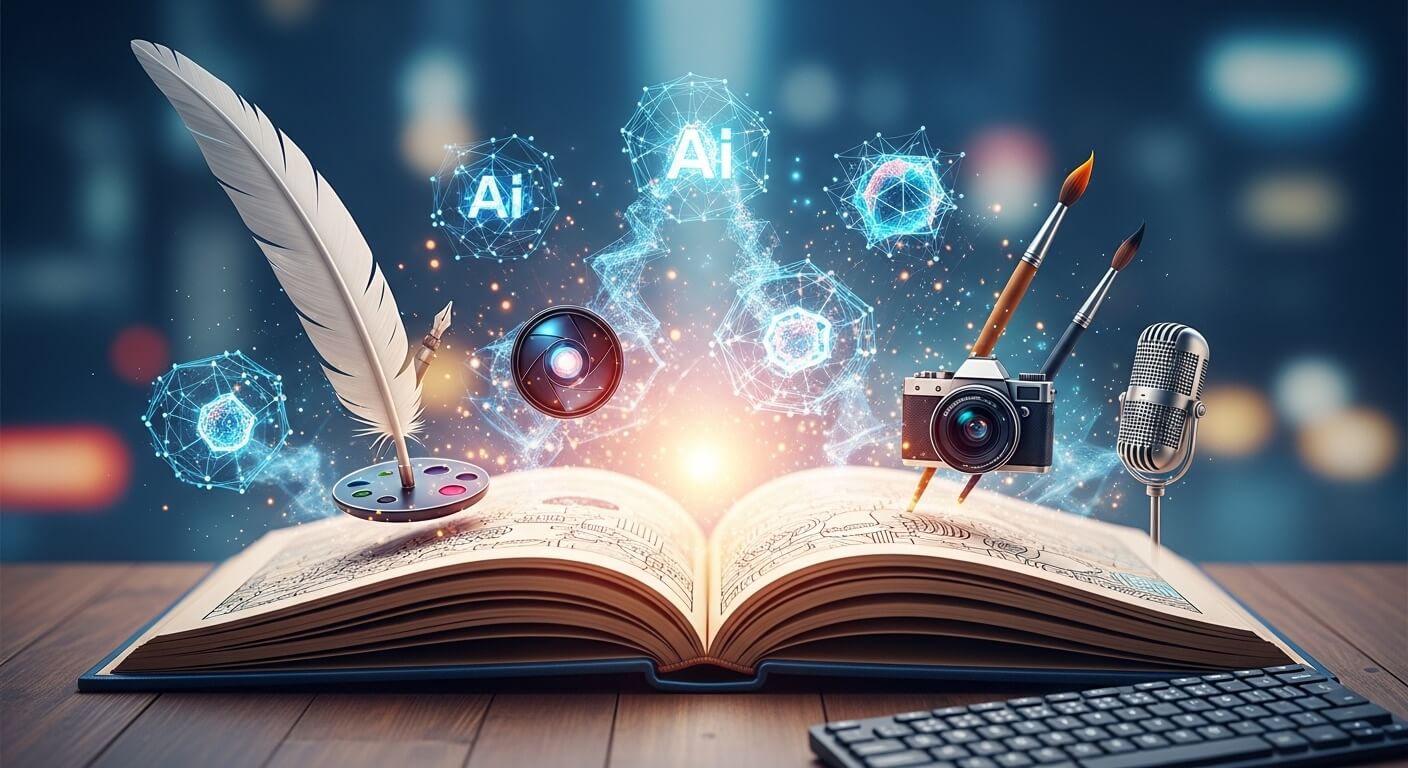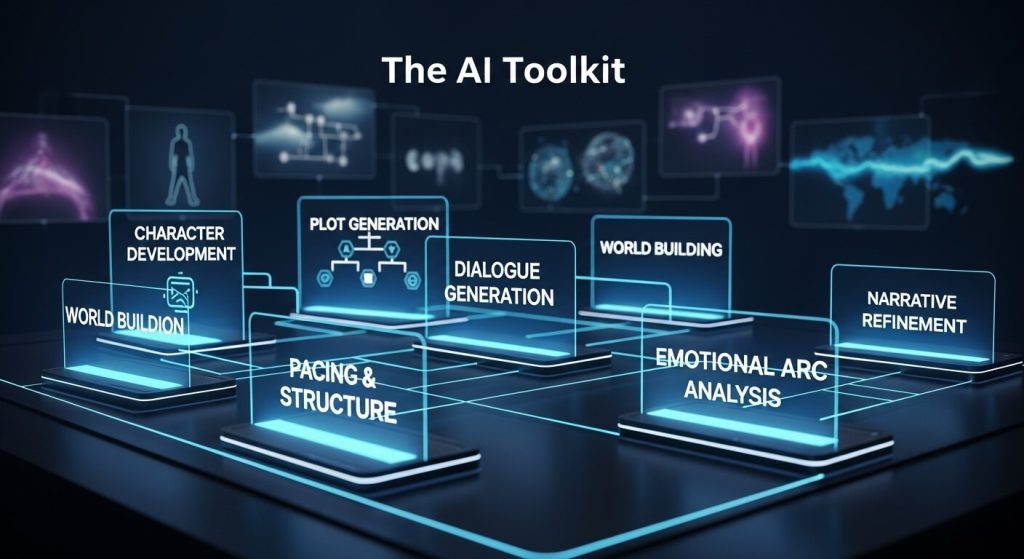
Online AI’s emergence opens up new possibilities for storytellers, moving the emphasis from automation taking the place of creativity to a potent creative collaboration. The goal of AI-enhanced storytelling is to use intelligent tools to enhance human creativity rather than to take over.
Creators may effectively break through creative obstacles, significantly boost content production efficiency, and extend their narrative possibilities into uncharted territory by using AI as a co-pilot.
By redefining the creative process, this collaboration promises to make crafting engaging stories more inventive and approachable than before.
Table of Contents
ToggleThe AI toolkit: Key functions in the storytelling process

AI is a flexible set of capabilities that can be incorporated into all stages of the creative process rather than being a single tool. These technologies serve as effective helpers to expedite and improve the narrative process, from the first spark of an idea to the finished multimedia result.
According to a Goldman Sachs analysis, generative AI has the potential to automate up to 25% of labor jobs, which would have a big impact on careers in media, entertainment, sports, the arts, and design.
This is a fundamental shift in creative roles rather than a replacement of jobs. It encourages the “creative director” paradigm, in which experts devote more time to strategizing, editing, and directing AI to carry out their vision rather than to manual production.
Ideation and conceptualization
AI acts as an unending brainstorming partner at the start of every project, assisting in overcoming the “blank page” issue.
- Brainstorming: Using a few keywords, instantly produce lists of possible storylines, character archetypes, locales, and main themes.
- Scenario generation: Investigate novel viewpoints and “what if” situations to uncover unorthodox storylines and shatter artistic conventions.
Drafting and expansion
After a concept is selected, AI handles the laborious task of initial composition, speeding up the process from concept to written content.
- First draft creation: Convert a straightforward prompt or succinct synopsis into an organized first draft that serves as a strong basis for editing and improvement.
- Content elaboration: Construct fully formed paragraphs, chapters, or sections from a skeletal framework or bullet points.
Refinement and polishing
AI is excellent at editing preexisting material to make sure the finished product is polished, understandable, and ideal for the target audience.
- Style & tone adjustment: With a single command, you can change the writing’s tone from official to informal, or from humorous to serious, as well as improve clarity and correct grammar.
- Audience adaptation: Adapting material to appeal to various target audiences, such as technical specialists, potential clients, or social media followers, requires little effort.
Multimedia enhancement
AI tools can assist in creating a more complex, multi-sensory experience, and modern storytelling transcends language.
- Visual generation: Produce storyboards, concept art, and excellent illustrations that graphically depict scenes, characters, and abstract concepts.
- Scriptwriting: Construct organized scripts with dialogue and scene descriptions for videos, podcasts, and dynamic presentations based on articles or key points.
Practical applications across content types
This move is a fundamental shift in the way creative work is done, not just a fad. Therefore, becoming proficient in AI is rapidly becoming a fundamental skill for professionals in the fields of business, media, and marketing.
Examining the practical, real-world uses of AI-enhanced storytelling is the simplest approach to understanding its potential. Across a range of industries, these tools are already transforming the way professionals communicate, engage with audiences, and achieve their strategic goals.
In order to obtain a competitive edge, people are looking at online AI degree programs as a result of the increased need for advanced skills brought on by this growing reliance on AI. These specialist courses teach students not only the “how” of employing AI tools, but also the “why”—how to use them strategically to solve difficult business problems and advance their professions.
Marketing and advertising
AI aids in creating tales that grab attention and motivate action in a busy digital environment. It can create captivating social media story arcs for certain platforms, produce thousands of ad copy variations for A/B testing, and condense a company’s vision into a compelling brand narrative that emotionally engages consumers.
Content creation and media
AI serves as a vital creative accelerator for journalists, bloggers, and videographers. It can quickly create organized scripts for podcasts and videos, plan lengthy articles, and develop entire blog post sections from a few main ideas. As a result, designers are freed from mundane duties to concentrate on high-level strategy, research, and incorporating their voice.
Business and corporate communication
AI is changing the way that information and concepts are communicated in the business sector. Organizing slides into a coherent, narrative flow that engages stakeholders helps create compelling presentations.
Additionally, it may transform complex, technical reports into readable and engaging summaries, guaranteeing that important insights are not only conveyed but also comprehended, retained, and implemented.
Best practices: The human-in-loop principle
It is crucial to use a “human-in-the-loop” approach and go beyond merely content creation strategies if AI is to reach its full creative potential. According to this theory, AI is a strong collaborator that needs human guidance, assessment, and improvement rather than an independent creator.
Achieving this synergy guarantees that the end product is genuine, strategic, and genuinely effective.
AI as a co-pilot
AI should not be your pilot, but rather your creative co-pilot. It is really good at coming up with ideas, getting past blockages in the creative process, and creating first drafts incredibly quickly. Its function is to offer a solid framework—a canvas of concepts and words—but never the completed work of art.
The human creator is responsible for the final strategic choices, complex narrative, and emotional resonance.
Prompt engineering
The quality of your input directly affects the quality of the AI’s output. The secret to guiding the AI is efficient, fast engineering. Give precise instructions about the tone, readership, preferred structure, and important topics to mention, rather than general requests.
Think of the process as a dialogue: create, evaluate, and then iteratively improve your prompts. You can steer the AI from a generic response to a customized, superior outcome through this back-and-forth conversation.
Edit and personalize
The final product is never an AI-generated draft. The human review process, where you update and customize the information, is the most important phase. Here’s where you add your own voice, personal stories, and make sure the messaging is consistent with the identity of your company.
Importantly, since AI might produce inaccurate data, constantly double-check assertions. This last step is what turns a generic piece of text into a compelling narrative that is genuine, reliable, and authentic.
The Future of content
In the end, the use of AI in storytelling is a tale of effective cooperation rather than replacement. It creates a dynamic synergy between AI’s enormous processing power, which can produce ideas and structures at scale, and human emotional intelligence—our special ability to empathize, be nuanced, and connect authentically.
The function of the content professional changes under this new paradigm. We transition from being active creators enmeshed in production techniques to becoming creative directors. Writing and creating are no longer our main skills; we now need to be able to clearly express our vision, pose pertinent queries, and direct these clever instruments to carry it out with flair and accuracy.
Instead of automating creativity, the future of content will focus on enhancing it and putting human ingenuity at the center of an ever-more-capable creative process.




